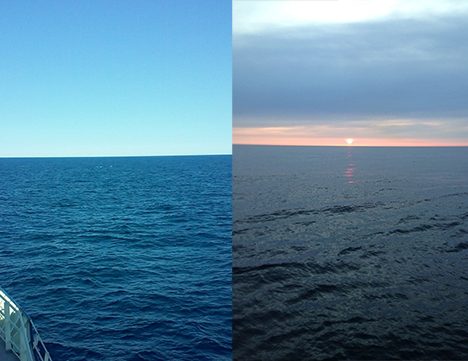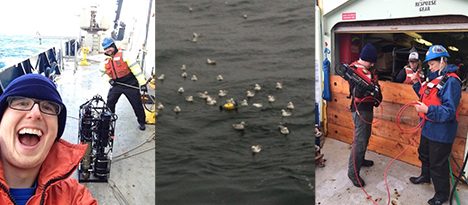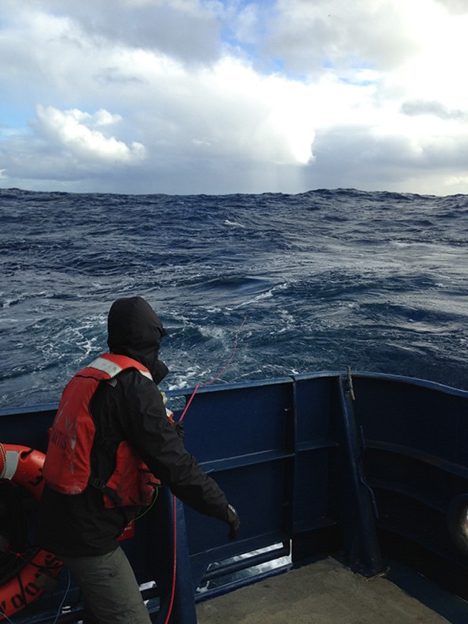The Light Side of Optics
Have you ever stopped to think about the color of the ocean? I mean, really stopped to think about why the ocean looks the way it does? If you’ve been to a variety of beaches, you’ve probably noticed that some waters are crystal blue, while others are emerald green, and still others can be yellowish-brown to even red! What causes these colors, and what can they tell us about the ocean?

A few of the varying colors of the sea. Photo: Kelsey McBeain and Stuart Halewood
And so begins our dive into the realm of Optical Oceanography. The role of the UCSB Optics team in this cruise involves deploying multiple instruments overboard, filtering many, many liters of water, and attempting to match all the different pieces of the puzzle to get a picture of why light behaves the way it does in the ocean.
As you might expect, many different things contribute to ocean color, but we can group them into five basic categories:
• Water – obviously the most abundant contributor, it actually slightly changes color based on temperature and salinity!
• Phytoplankton – the plants of the sea! As diverse as they are abundant, they influence ocean color based on their size and the amount and type of pigments such as chlorophyll.
• Non-Algal Particles – all other particles in the ocean. This includes dirt, sand, and the clumps of organic material that sink to depth and make marine snow.
• Colored Dissolved Organic Material – the fraction of dissolved organics that interact with light. I like to think of this as brewed tea, but so watered down that it has a light yellow color. It can also be called gelbstof, German for “yellow stuff”.
• Bubbles – formed from breaking waves, photosynthesis, and respiration, they are highly reflective and change the light field both above and below them. For this reason, they are very annoying when they get into our instruments when we’re trying to measure everything else!
Lots of research has been done to characterize all the different ways these 5 constituents absorb and reflect all the different colors of light, and then some! With this information, we can look at how light availability changes with depth and piece together the puzzle to find the amount of each thing at different depths.

The IOP Package, the HyperPro + angry birds, and the C-OPS. Photo: James Allen and Nicole Estephan
Over the course of a station (depending on weather), we deploy three different packages. The first, the IOP Package, is a big box of multiple instruments each firing their own combo of bright lights and lasers. The HyperPro is a floating instrument that takes reading of light levels just above and below the surface of the ocean (when it isn’t being pecked at by birds). The third, and my favorite, is the Compact Optical Profiling Spectrometer, or C-OPS. Stuart Halewood and I deploy it midday at high noon so that we can match time/data with some ocean color satellites passing overhead (hopefully it isn’t cloudy!). C-OPS has two clusters of sensors on it. One looks down at the spectrum of the light bouncing back up at it from below, and the other looks up and measures light coming down. It measures many different wavelengths as it sinks and sends this data back to us in real time. Since we just want to measure light straight up and down, we don’t want any tilt as it sinks, which is sometimes pretty difficult with all these subsurface currents pushing it around. After we pull C-OPS up, we’ll go look at the profile and measure how fast each color of light seems to “disappear” with depth. By modeling these changes, we’ll be able to get a high-res map of many different constituents at once.

Yes, we hand-deploy a few of our instruments, even in rough weather. Photo: Nicole Estephan
Our ultimate goal is to reconcile all the changes in light behavior due to everything in the water column. With this data, satellites measuring ocean color from orbit will be better equipped to tell us how the ocean is changing on many different scales of time and space! Talk about seeing the ocean in a new light!
Written by James Allen




Does the salinity affect the color of water?
Yes, the optical properties of pure seawater such as absorption and scattering of light are affected by salinity. And it is the absorption and scattering properties of water that primarily determine its color.